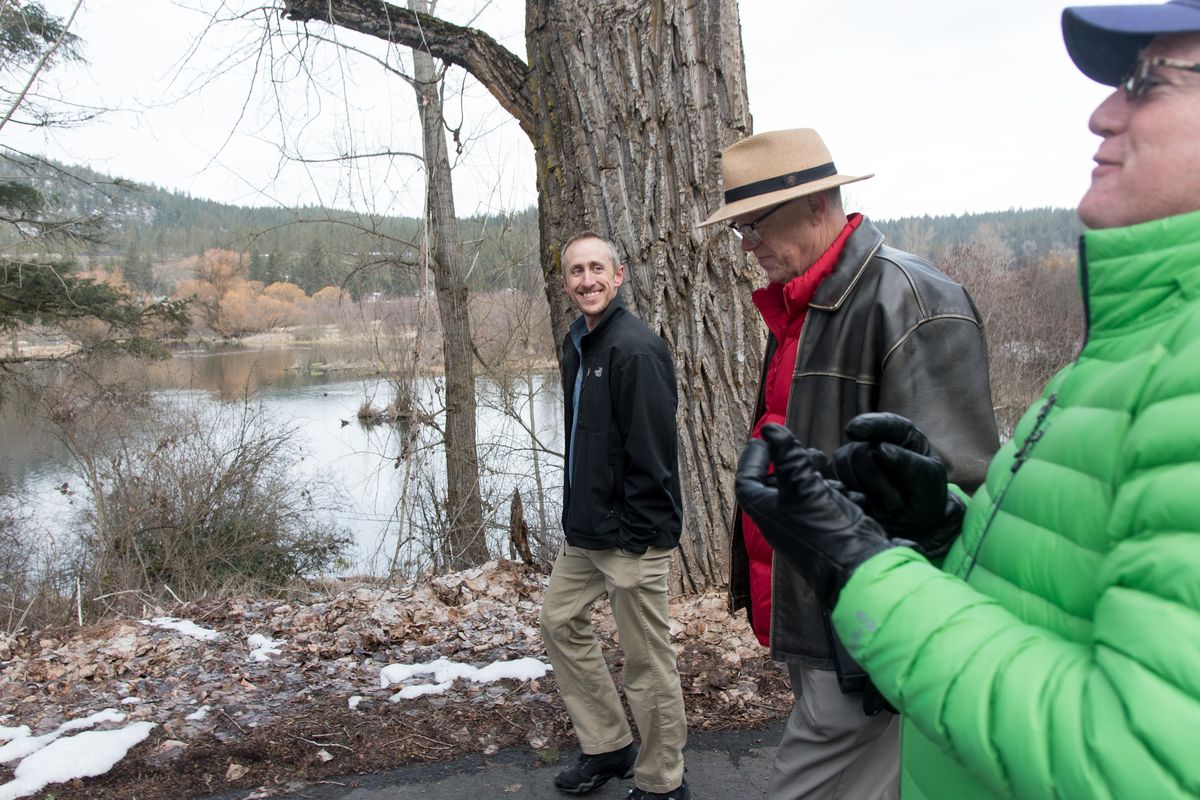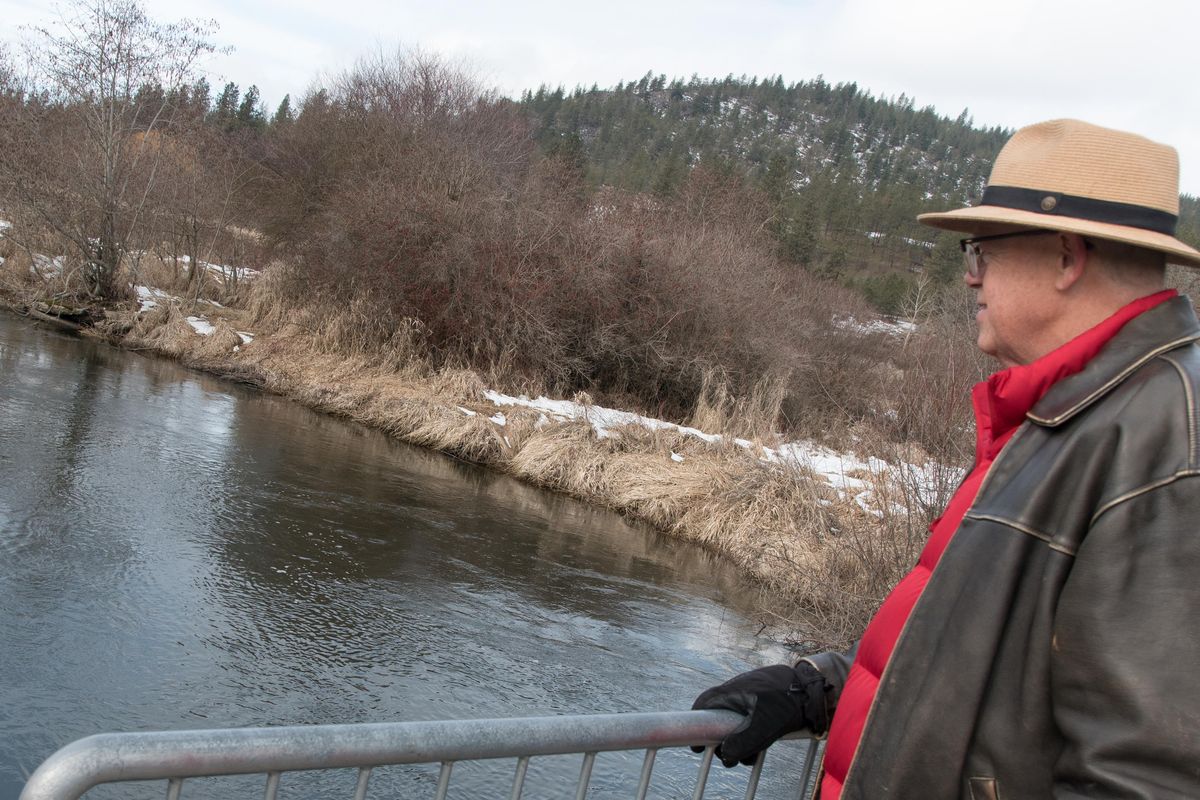State land long used as unofficial park in north Spokane may be incorporated into Riverside State Park
Mike Schmeltzer (right), Rob Allen and Chris Zeller walk near the Little Spokane River. For decades the 112 acres have been used as an informal urban park by Fairwood neighborhood residents. Now Fish and Wildlife is trying to surplus the property. Allen and others hope the land can be incorporated into the Riverside State Park boundary. (Eli Francovich / The Spokesman-Review)Buy a print of this photo
It’s a peaceful river valley, one in which it’s not uncommon to see moose, beaver, bald eagles and blue herons. What’s more, this thin slice of wilderness is just minutes from busy north Spokane.
For decades, residents of the Fairwood neighborhood have recreated on the 112 acres, which is owned by the Washington Department of Fish and Wildlife.
But a recent decision by Fish and Wildlife to surplus the property has left some worried that the area, known as Waikiki Springs, will no longer be publicly accessible.
“You hear so many people say they were down here as a kid and did this and that,” Rob Allen said. “It would be a shame if it got blocked off.”
Allen lives in the Fairwood neighborhood, which is adjacent to the land. He runs the Fairwood Farmer’s Market and has for the past several years advocated to preserve and protect the 112 acres along the Little Spokane, which he calls the Middle of the Little.
Fish and Wildlife staff are sympathetic to Allen’s concerns and would like to see the land remain accessible. But the department, which is primarily focused on preserving and protecting fish and wildlife habitats while also allowing for recreation, isn’t well suited to manage an urban park, said Steve Pozzanghera, the regional director for Fish and Wildlife.
Instead, Pozzanghera believes the best course would to incorporate the land into the Riverside State Park boundary area. Washington State Parks would then manage the land.
However, before anything like that happens the agencies’ respective governor-appointed commissions would have to approve those changes, Pozzanghera said.
“I would just say that currently both sides agree,” Pozzanghera said. “And each of us would do our respective parts to see that would come to fruition.”
Allen has talked to representatives from both the Parks Department and Fish and Wildlife. And while he’s happy that staff are on-board with preserving access, he’s anxious for it to be finalized.
“We want to get it memorialized,” he said.
A series of public meetings earlier this year convinced Michael Hankinson, the parks planner for Washington State Parks, that the Waikiki Springs area was a beloved public resource.
“I can safely say that people love this place and they want to keep it public,” he said.
The Washington State Parks and Recreation Commission will meet in Spokane in May, he said. At that time parks staff will present the commission with a staff recommendation for the land. Although the recommendation is not finalized, Hankinson said he’s leaning toward recommending incorporating the 112 acres into the Riverside State Park boundary area and preserving the same level of access that neighbors have grown accustomed to over the years.
After the recommendations are presented in May, Hankinson said the commission could vote on changes as early as July 12. However, he stresses this could change and is only his “best guess.”
“I think people have grown accustomed to recreating there and they don’t want that to change,” he said. “And they want to know which agency is best positioned to manage it going forward.”
WDFW has owned the land since 1973. And while the 112 acres are contiguous, they’re actually two separate properties. When the land was purchased in the 1970s the department hoped to open a fish hatchery. That never happened. Instead, the department invested in the Spokane hatchery, leaving the Waikiki Springs property vacant.
In the meantime, neighbors started accessing the public land via a switchbacked road originally built to service the Waikiki Dairy.
For years the land was mostly an unofficial neighborhood secret. However, the creation of the Discover Pass system six years ago increased use, Pozzanghera said. A posted Discover Pass sign on the property’s tiny trail head started attracting more users.
“By posting that site you got a lot of attention,” he said. “Suddenly the use of the property has increased.”
That increase has caused some conflicts with private land owners along the river, said Allen. That’s another reason he’d like to see the Parks Department manage the land.
“Since it’s not designed as a park there are no park boundaries and no park rules,” he said. “People can’t tell where the boundary is and they wander off onto private property.”
Allen and others have taken on much of the maintenance and cleanup of the area. For instance, last summer neighborhood volunteers hauled 12 garbage bags of trash off the land.
While it’s unlikely the land will be sold to a private developer, it is possible, said Hankinson. One of the two parcels that make up the 112 acres was purchased with Land Water Conservation Funds – federal money that is administered by the Washington State Recreation and Conservation Office. That piece of land could, through a complicated process, be sold to a private developer.
“Is it possible that it could be made private? The answer is actually yes,” Hankinson said. “It’s a very low possibility but it’s absolutely possible.”
And that’s why Allen and others are so keen on keeping pressure on the situation.
“We figured that if we made enough ruckus they would not just sell it outright,” Allen said.

